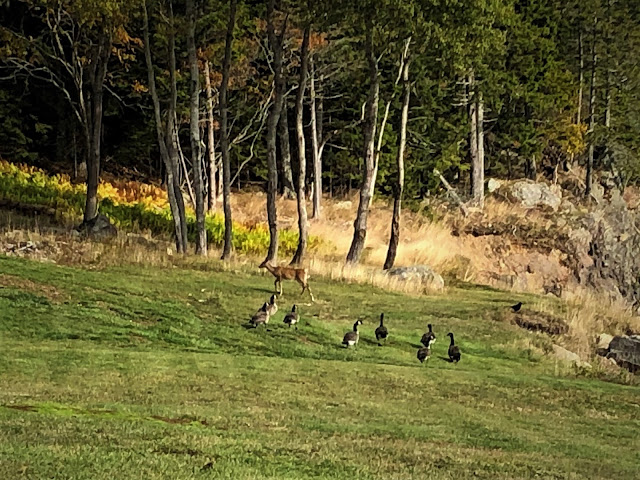THE FUNDY ISLES
Saying “Nothing to see or do there!” to Elva and me is like waving a red flag in front of a bull. Experience has taught us that there’s always lots to see and do if you travel with the right attitude and an open mind.
We left Saint John after spending the weekend with Sylvie and her family and headed to Black’s Harbour and the ferry to Grand Manan Island. The 9:30 crossing wasn’t that crowded and it was a beautiful fresh fall morning, ideal for standing in the wind on the passenger deck, watching the seabirds and taking in the sights. We slipped past the Swallowtail Lighthouse and into North Head two hours later and headed south to explore the island. Sylvie had recommended we cross over to White Head Island if we had the time, so we drove right to the ferry dock in the village of Grand Harbour.
Like North Head, Grand Harbour is a busy fishing port. I watched as a crane lifted a boat out of the water, rolled it halfway across the parking lot and deposited it in its winter resting spot. Three men in dories off-loaded rock weed (Ascophyllum nodosum) into a tractor-trailer using a modified hay rake. The rock weed is raked and gathered at low tide and spread out to dry before being shipped off-island where a compound called alginate is extracted. Alginate is used as a thickening agent in foods, cosmetics, and some paints.
White Head Island is a jewel; just about the right size to walk around in a day. As we sailed into the harbour on the tiny ferry, I thought of the fortunes we’ve spent on cruises that took us halfway around the world, sailing into places that couldn’t hold a candle to White Head. We even had a welcoming committee of local cormorants. One of the ferry deckhands told me about 200 people live on the island year-round; the only store closed down two years ago; you can’t get gas there anymore; and the elementary school is down to five students. Still “I wouldn’t live anywhere else”, he said. “The deer on the island are terrible small, so I go to the mainland to get mine every fall.” Now there’s a man who’s got his priorities straight!
From Grand Harbour, we turned south, came across a venison farm, stopped in pretty Seal Cove, then drove to the southern tip of the island, Southwest Head. Its basalt cliffs rival those of the west coast of Ireland and the colours were magnificent. Our B&B, the Compass Rose, offered a perfect view of the busy harbour and breakfast over the water.



Not a problem! We spent an enjoyable few hours driving around Deer Island, taking every road we could find, discovering cute coves along the way. We took a hike through the Clark Gregory Nature Preserve before viewing the Old Sow, said to be the second-largest whirlpool in the World! For sheer excitement, it’s rivalled only by Moncton’s Tidal Bore…
Along the way, we learned where Deer Island got its name. They’re everywhere! This guy stood out from the crowd with his white body and brown head. I imagine the does will come from miles around to keep company with this young buck when he grows into his antlers. And what could be more Canadian than a meeting of these two icons, whitetail deer and Canada geese!
Our five-day visit to the Fundy Isles was an opportunity to see a part of the Maritimes that had thus far eluded us. Although they’re a bit off the beaten track, Grand Manan, White Head, Minister’s, Deer, and Campobello islands are well worth visiting. The fall colours were spectacular and the smells and sounds of the ocean added a pleasant dimension to our explorations. We learned things about the fishery and met many friendly people along the way. While this may be the last of our travels for a while, it was a good way to say goodbye to the summer season.
























































